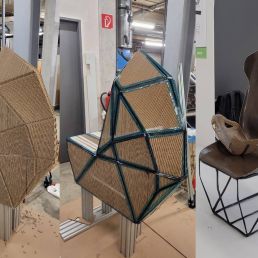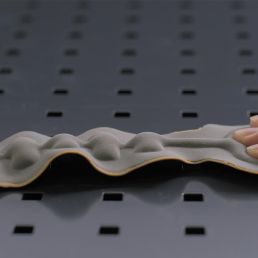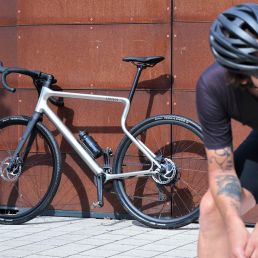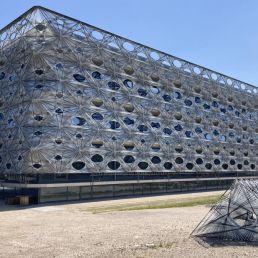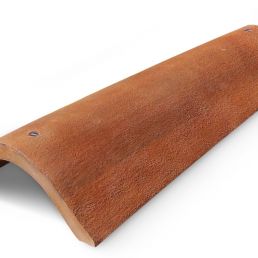Materials Revolution – Innovative materials as a progressing tool in the architectural work
Convention Center at Airport City · Tel Aviv/Israel
10 December 2014

The trend towards sustainable product development and sustainable design is especially important in the design industry, where it has been embraced by architects and industrial designers. More and more, creative industries are meeting the needs of a sustainable product culture by incorporating the latest scientific discoveries into their work. This brings research, technology, architecture and design together, particularly within the allocation of materials.
Designers are currently forming a new understanding of how products might be sourced and produced. They are looking increasingly towards producing in line with nature, and have made biological biodegradability and natural recyclability top priorities when seeking out new materials. Interior made by algaes, construction panels made of rice husks, packaging materials from mushroom or bamboo composite material instead of concrete steel: These are just some of the most striking examples of a development that will take on a revolutionary character in the near future.
In his presentation Dr. Sascha Peters pointed out some of the most spectacular material innovations of the last months and will show some examples for the use of sustainable materials in architecture and design. He especially focussed on the implementation of materials as a progressing tool in the architectural work.
“The international Convention for innovation in Design and Architecture”
9:30-9:40
Introduction
– Iris Moshli (General Director)
– Amir Hayek (General Director of the Manufacturers Association of Israel)
– Carmela Jacobi (Architect, Israel)
9:40-10:20
“Materials Revolution – Innovative materials and their implementation as a progressing tool in the architectural work”, Dr. Sascha Peters (Haute Innovation, Germany)
10:20-11:00
“What if we can Print 3D Buildings? The significance and implications of 3D printing on architecture, the future roles of planners, urban environment and on life style.”, Hans Vermeulen (DUS Studio, The Netherlands)
11:00-11:30
“BIM to BEM – Advanced computerized technology enabling to plan better and wiser thus usage of thermal and climatic simulation.”, Iftach Harari (Architect, Israel)
12:10-12:50
“Bio Mimicry, Innovation Inspired by Nature”, Yael Helfman Cohen, Israel (General Director, Israel Bio Mimicry Organization)
12:50-13:30
Panel on the topic: Innovation in the academia
Host: Architect Prof. Yossi Freidman
– Prof. Shraga Kirschner (Shenkar College for Engineering and Design)
– Nisan Varshawsky (Architect, Holon Institute of Technology)
– Carmela Jacobi (Architect, Management College, School of Design)
– PhD Eran Noiman, David Azrieli (Architects, Architecture College, Tel Aviv University)
– Yuval Yaski (Architect, Bezalel, Academy of Arts and Design, Jerusalem)
– Irit Zeref-Nethanyahu (Architect, The Neri Bloomfield School of Design and Education, Haifa)
13:30-13:50
Pecha Kucha “Innovation in Architecture and Design”
14:40-15:20
“Urban-Matters, Data Craftsmanship as a new design practice in Urbanism”, Gary Freedman (Architect, SHA-GA Studio, London)
15:20-16:00
“Like a Ship Architecture”, Masahiro Harada (Architect, Mount Fuji Studio, Japan)
image: Mycotecture (source: Phil Ross)
Ecoblaq molecular wood colours
23 March 2024
Ecoblaq is a molecule manipulation method, a natural chemical reaction, making…
Natural fiber reinforced car seat
22 October 2023
The focus of the project "Design for Recycling" is a seat shell that is made…
MotorSkins morphing textiles
19 April 2022
Berlin based start-up MotorSkins designs and produces textiles with embedded…
3D Pioneers Challenge 2022
15 December 2021
The 3D Pioneers Challenge 2022 adresses tech pioneers who pave the way for…
IGNIS – Light from waste heat energy
12 August 2020
The availability of affordable, independent and, above all, clean electrical…
Brake disc with reduced fine dust
21 April 2021
Fine dust endangers our health. One of the main sources is traffic, especially…
Texoversum
15 July 2023
With the "Texoversum", Reutlingen University has put into operation a training…
Invisible Terracotta Solar Rooftile
10 May 2023
The family-run business Dyaqua has developed a technology to integrate a…
Xarvio – Digital Farming
8 January 2021
BASF Digital Farming GmbH has received the renowned Crop Science Award for the…

